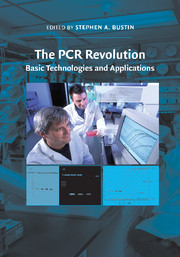Book contents
- Frontmatter
- Contents
- Contributors
- Foreword by Russell Higuchi
- Preface
- I BASIC TECHNOLOGIES
- 1 Real-time polymerase chain reaction
- 2 Thermostable enzymes used in polymerase chain reaction
- 3 Inventing molecular beacons
- 4 Rapid polymerase chain reaction and melting analysis
- 5 Polymerase chain reaction and fluorescence chemistries: deoxyribonucleic acid incarnate
- 6 Analysis of microribonucleic acid expression by quantitative real-time polymerase chain reaction
- 7 Miniaturized polymerase chain reaction for quantitative clinical diagnostics
- 8 The road from qualitative to quantitative assay: What is next?
- 9 Taking control of the polymerase chain reaction
- II APPLICATIONS
- Index
- Plate section
- References
9 - Taking control of the polymerase chain reaction
Published online by Cambridge University Press: 25 January 2011
- Frontmatter
- Contents
- Contributors
- Foreword by Russell Higuchi
- Preface
- I BASIC TECHNOLOGIES
- 1 Real-time polymerase chain reaction
- 2 Thermostable enzymes used in polymerase chain reaction
- 3 Inventing molecular beacons
- 4 Rapid polymerase chain reaction and melting analysis
- 5 Polymerase chain reaction and fluorescence chemistries: deoxyribonucleic acid incarnate
- 6 Analysis of microribonucleic acid expression by quantitative real-time polymerase chain reaction
- 7 Miniaturized polymerase chain reaction for quantitative clinical diagnostics
- 8 The road from qualitative to quantitative assay: What is next?
- 9 Taking control of the polymerase chain reaction
- II APPLICATIONS
- Index
- Plate section
- References
Summary
INTRODUCTION
All living organisms use nucleic acid to store the genetic code. In most cases, this is in the form of deoxyribonucleic acid (DNA), although some viruses use a ribonucleic acid (RNA) molecule. DNA is used as the template for production of various RNA molecules. These have several functions, including regulation of the transcription of messenger RNA (mRNA), which is an intermediary molecule used in turn as the template for the production of proteins. It is proteins that are generally considered to be the active molecules of the cell. Of course there are many exceptions to this general pathway or “Central Dogma,” and complex regulatory mechanisms are constantly being elucidated. Nonetheless it serves as a starting point for our discussion on the use of the polymerase chain reaction (PCR), because the study of these genetic materials is critical for our understanding of most aspects of life science. PCR is currently the cornerstone tool for the study of both DNA and (indirectly) RNA.
DNA ANALYSIS IN THE PRE-PCR ERA
Within human and other eukaryotic cells, DNA is compacted and organized into a number of chromosomes. Cytogenetic studies of entire chromosomes use banding patterns resulting from Giemsa staining (G banding) as structural markers. By the 1950s the techniques relating to G banding were sophisticated enough for the human karyotype (chromosome complement) to be defined as forty-six chromosomes that are arranged as twenty-two matching pairs and two sex-related chromosomes. In 1959, Jerome Lejeune et al. discovered that an additional chromosome, later accepted as number 21 (trisomy 21), was consistent with Down's syndrome.
- Type
- Chapter
- Information
- The PCR RevolutionBasic Technologies and Applications, pp. 129 - 152Publisher: Cambridge University PressPrint publication year: 2009



